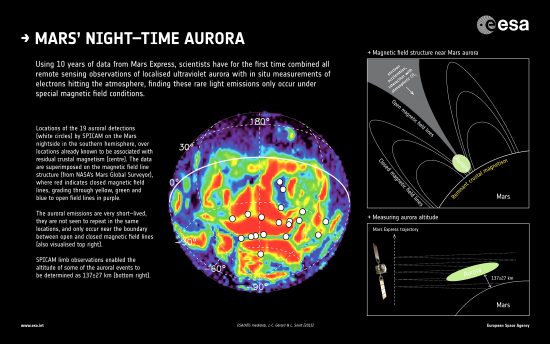
Night time aurorae on Mars. Credit: ESA/ATG medialab; data: J-C. Gérard & L. Soret (2015). Click to enlarge.
Sep 22, 2017
The MAVEN Mission continues in orbit around Mars.
When the gradual processes of evolution are the only ideas considered, the history of the planets is impossible to determine. In the Electric Universe view, each planet took part in several catastrophic events. The most recent of those electric storms left permanent marks cut into planetary bodies. Questions about Mars, in particular, need answers from that perspective.
What is the relationship to planetary atmospheres and the behavior of a variable electric Solar System? Can Mars provide examples for that electrical connection? Does Mars offer clues to the catastrophic events in the planet’s recent past?
MAVEN found aurorae in the South Polar region that were first detected by Mars Express. As mentioned, Mars has no intrinsic magnetic field, but it does possess bands of crustal magnetism in its lower latitudes. Astrophysicists do not know what caused the peculiar magnetized stripes that seem to focus on a specific point in the south, or why the auroral events should be associated with them.
Non-thermal radiation readings (evidence for lightning discharges), independent of the surface temperature, and during one of the giant dust storms, were gathered by MAVEN’s Langmuir Probe and Waves (LPW) instrument. To the surprise of the mission team, a dust cloud in the Martian atmosphere at around 150 kilometers above the surface was found to be electrically charged.
Martian dust devils draw tons of dust through thousands of funnels and carry it for hundreds of kilometers. What causes those dust storms and why are they electrified? The air is 100 times thinner on Mars and averages 75 degrees colder than Earth, yet dust storms sometimes obscure an entire hemisphere. NASA scientists assume that the non-thermal radiation MAVEN detected was caused by electric charge building up in the gyrating dust grains.
In an Electric Universe, no bouncing dust grains are necessary. Charge separation already exists in the atmosphere, whether on Earth or Mars. Without watery clouds to send lightning down to ground level, electric discharges on Mars create giant whirlwinds in an electric circuit. It is that same circuit that drives weather systems on Earth. If this is true, then Martian “dust devils” and those on Earth are both illustrations of how electricity behaves in the Solar System.
Electrons spiraling in a magnetic field emit synchrotron radiation, the most common type of “non-thermal” radiation. Dust storms, spinning at hundreds of kilometers per hour, create electromagnetic fields that confine charged particles, accelerating them around the vortex. Rapid acceleration, coupled with high voltages in the dust, cause an ultraviolet glow, along with a surge in energetic electrons seen by the LPW instrument at the onset of the aurora.
Bands of electromagnetism in the crust and planet-wide electric dust storms are remnants of energetic influences on Mars in the recent past. Its atmosphere and its surface were most likely destroyed, in large part, by electric arcs of planetary dimensions. The scars left by those electric arcs are often mistaken for water channels and canyons, as well as other anomalies.
Stephen Smith












